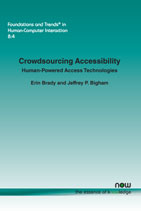Crowdsourcing Accessibility: Human-Powered Access Technologies
By Erin Brady, Indiana University - Purdue University Indianapolis, USA, brady@iupui.edu | Jeffrey P. Bigham, Carnegie Mellon University, USA, jbigham@cmu.edu
Abstract
People with disabilities have always engaged the people around them in order to circumvent inaccessible situations, allowing them to live more independently and get things done in their everyday lives. Increasing connectivity is allowing this approach to be extended to wherever and whenever it is needed. Technology can leverage this human work force to accomplish tasks beyond the capabilities of computers, increasing how accessible the world is for people with disabilities. This article outlines the growth of online human support, outlines a number of projects in this space, and presents a set of challenges and opportunities for this work going forward.
Crowdsourcing Accessibility
Crowdsourcing Accessibility: Human-Powered Access Technologies outlines the dimensions of human-powered access technologies. While people with disabilities often make use of assistance from companions and others around them when they have an access problem, there are a number of advantages to creating scalable technology to replicate and extend this type of interaction with remote assistants. Doing this effectively, however, involves making a number of decisions and is more complicated than it appears. Not only are more people potentially involved, each with their own expectations and needs, but their contributions must be effectively coordinated, managed, and rewarded.
Crowdsourcing Accessibility: Human-Powered Access Technologies looks at the growth of online human support, outlines a number of projects in this space, and presents a set of challenges and opportunities for this work going forward
